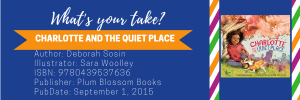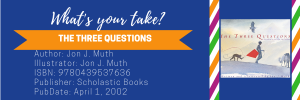by Seemi Aziz, University of Arizona, Tucson, AZ, and Melissa Wilson, Leeds Trinity University, Leeds, West Yorkshire, UK
Rounding off the first month of 2021, we discuss Charlotte and the Quiet Place and take one last look at how mindfulness may help us during this stressful times.
The texts discussed this month may offer readers (and listeners) some peace during these most turbulent times. They are books that thematically deal with the concept of mindfulness through a narrative. There are many new books being marketed for children that are guides to mindfulness practices. A quick browse on Amazon yields pages of “activity books” that offer to help children process feelings, step-by-step manuals for doing meditation with children, and even books to help teach children “growth mindsets”.
Sometimes the best way to deal with a difficult present and an uncertain future is to lose yourself in someone else’s story. Through reading, or being read to, you can experience different ways of living on a deep level. These experiences can give much succor and “practice runs” at figuring out how to live a life well.








 By Seemi Aziz, The University of Arizona, Tucson, AZ and Janelle B. Mathis, University of North Texas, Denton, TX
By Seemi Aziz, The University of Arizona, Tucson, AZ and Janelle B. Mathis, University of North Texas, Denton, TX


